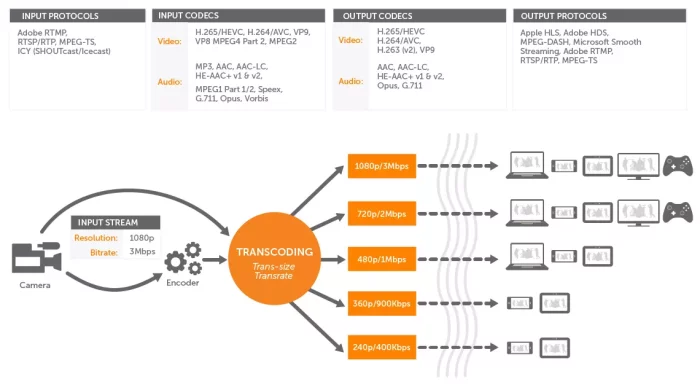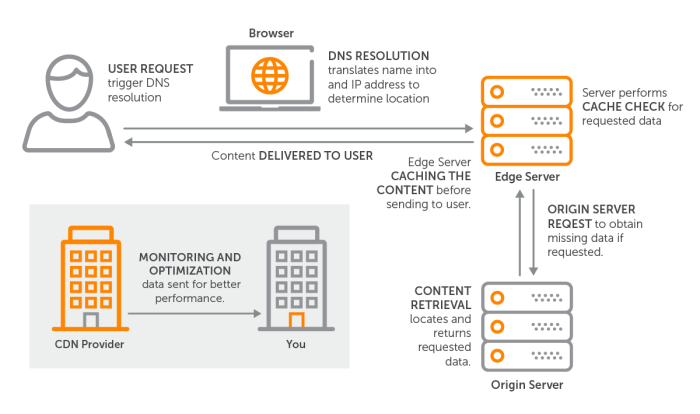How VOD Streaming Works (Update)
When most people think of video streaming, they envision popular services like Netflix, Hulu, and DisneyPlus. These video-on-demand or VOD streaming services act as content platforms from which users can view pre-recorded videos at their own convenience from their chosen devices. But while the benefits to users are well-known and clear-cut, what about the benefits to businesses that are just dipping their toes into content creation and video marketing? And how can those companies build a VOD service that suits their needs without breaking the bank? In this article, we’ll talk in depth about how VOD streaming works and how businesses can take advantage of it.
Table of Contents
- VOD Streaming Use Cases
- VOD Streaming Workflow Overview
- Encoding: Using the Correct Video Files
- Transcoding and Transmuxing: Optimizing Your Video
- Content Management: Organization and Storage
- Distribution: VOD Streaming Across a CDN
- Playback: Ensuring a Successful Stream
- Analysis: Optimizing Your VOD Streaming Efforts
VOD Streaming Use Cases
Once upon a time, if you wanted your video content to be seen, then you either had to convince a broadcast network to air it or invest in physical media. Alongside live streaming, VOD streaming has been a game changer for many businesses, allowing content creators to bypass the usual gatekeepers and engage more directly with audiences.
Being Competitive
Granted, for entertainment with high production value (a la your favorite television show), you’re still likely looking to appeal to existing VOD services to be seen by your desired audience. However, lesser-known VOD services are siphoning viewers away from the heavy hitters with the promise of less expensive subscriptions. Long story short, Netflix may have started this gravy train, but they aren’t monopolizing it by any means.
Non-Entertainment Use Cases
Then there’s also the matter of other types of VOD content. Not everything is about the latest binge-worthy television show. In fact, VOD streaming has long been in use for education, government, marketing, and other needs. That’s why just about every business under the sun (present company included) has a YouTube channel.
Use Cases Quick Guide
- Supplementary fan content for sports broadcasters and teams
- Lessons and lectures for ongoing education and licensing needs
- Repository of speeches, debates, and other private and public government/political content
- Collection of product demos, tutorials, and more to bolster your customer support efforts
- Behind-the-scenes content and other “fun” brand building tidbits
- Webinars, roundtables, and more to feature thought leadership within the company
That’s right. The same technology behind your Netflix subscription can be applied to fitness videos, podcast libraries, eSports highlights, and more. It also makes sense whether you’re talking to a limited audience or the biggest one you can muster. The biggest surprise, however, might be how easy it is to break away from YouTube and build your own.
VOD Streaming Workflow Overview
Let’s start with a top down look at how VOD streaming works. Assume you already have the content recorded that you want to make available on demand. Now it’s time to prepare that media for storage and distribution on demand.
- Encoding: Choose the correct video files.
- Transcoding and Transmuxing: Upload and optimize your video for delivery.
- Content Management: Store files in an intuitive way with effective metadata.
- Distribution: Content delivered across a video CDN.
- Playback: Online video player receives, decodes, and plays video.
- Analytics: Data comes full circle to help you optimize your workflow.
These are the basic building blocks of your VOD streaming workflow. However, each of these steps can be more complicated than they first appear.
Encoding: Using the Correct Video Files
Encoding video files refers to packaging them for delivery across a network. Your raw video files are too large to be uploaded to a database and must be compressed (another term for encoded in this context) with the help of codecs. In many cases, your camera may have an encoder built in, as is the case with live streaming. However, it’s possible your prerecorded video is still raw, and you need to use an encoder to compress it for delivery.
Term Cheat Sheet
- Encoding – The act of compressing files to reduce their size and prepare them for streaming delivery.
- Encoder – Hardware or software that helps you encode your video files.
- Codec – Technology that does the actual compression by applying an algorithm to the video files. Examples: H.264, AV1, and VP9.
- File Container – Files that contain compressed video, associated codec, and metadata. These containers (aka wrappers) refer to the file “type”, such as .mov and .mp4.
So how do you determine which codec and subsequent file container or best for your needs? Start by working backwards. The types of playback devices you want to be able to reach will determine which streaming protocols you should use, which in turn require specific codecs and wrappers. For example, the HLS protocol requires .ts file containers while MPEG-DASH requires .mp4. While codecs, like H.264, can compress files into a range of wrappers, you’ll still want to make sure your required wrapper is supported by your chosen codec.
Transcoding and Transmuxing: Optimizing Your Video
Once uploaded to the streaming platform, your data files are optimized for online streaming in several ways. This is where the protocols such as HLS and DASH come into play. Your files are converted to meet various packaging requirements for playback across devices. Which protocols you use for the various video files depend on the file containers you selected in the first step.
Term Cheat Sheet
- Transcoding – The act of decompressing, altering the contents of a file, and recompressing/re-encoding it for delivery.
- Transmuxing – The act of changing the container format of a media file. This does not require the file to be decompressed.
- Transrating – The act of changing the bitrate of raw media files before recompression. This is a type of transcoding.
- Transizing – The act of changing the resolution of raw media files before recompression. This is a type of transcoding.
What if you decide you want to optimize a video file for use with a protocol that doesn’t match your chosen wrapper? You don’t need to go back to the drawing board. Transmuxing allows you to alter the outside of your video package, essentially changing the file type to match different protocol requirements.
Of course, you can also make more substantial changes to your media files by decompressing and recompressing them. This process, known as transcoding, allows you to adjust the resolution (transizing) or bitrate (transrating) of the files. This process allows you to differentiate your video packaging for various other playback needs. Most notably, transcoding is used to create multiple versions of the same video files at different resolutions and bitrates for adaptive streaming workflows. Processes like adaptive bitrate streaming (ABR) allow you to optimize video quality for not only different playback devices, but also individual viewers by factoring in bandwidth limitations.
Finally, this process often includes encryption to secure streaming content and prevent unauthorized usage, such as screen recording. Do this using a multi-key Digital Rights Management (DRM) system. Encryption is highly recommended but not essential for a successful VOD stream.

Content Management: Organization and Storage
Now your files are ready for streaming, but your job is not quite over. Use a content management system (CMS) to organize your files. Here you can connect metadata to your video files, tag them with labels, and otherwise categorize them to keep them organized and stored in a centralized database.
This essential step in the process has direct bearing on the customer experience. This is how they are able to browse and search your VOD streaming database. Accurate metadata makes for quick and easy search results that play immediately upon selection, which in turn leads to satisfied viewers who are more likely to return.
Distribution: VOD Streaming Across a CDN
Congratulations! Provided you’ve followed the first steps correctly, carefully considering your video file formats, content organization, security, and more, your job is essentially done (at least as far as these video files are concerned). Now you just need a viewer to come and request access to one of your videos.
Term Cheat Sheet
- Origin Server – The central server where content is stored for distribution across the CDN.
- Edge Server – Servers at various physical locations, often globally.
- Caching – The act of storing content locally on edge servers for easier distribution to nearby viewers.

When a viewer requests a video, the content delivery network (CDN) kicks into gear. This network of servers typically consists of an origin server that hosts all of the content and several edge servers that are located at various remote locations. By caching content on edge servers for faster retrieval and balancing demand across the whole network, video CDNs promote faster and more reliable streams regardless of audience size or distance.
The viewer’s browser starts by requesting the content from the nearest edge server. If the edge server has the content cached, it returns it immediately and the video starts to play. If it doesn’t, it requests it from the origin server and then caches it for future requests. CDNs are not required for distributing VOD streaming content but they can play a significant role in promoting a positive viewer experience.
Playback: Ensuring a Successful Stream
The viewing experience is now in the hands of the viewer’s playback device, right? Yes and no. While it’s true that their television, laptop, or smartphone plays an important role in the viewing experience, you have more control over this part of the process than you might think.
We’ve already covered how you can optimize the video files for playback across a range of devices and bandwidth limitations. However, you also have control over the player itself. After all, the browser and device might be theirs, but the embedded online video player that decodes and displays the content, is yours. Make sure it’s a good one.
Analysis: Optimizing Your VOD Streaming Efforts
Providing a high-quality streaming experience is a dynamic process. Regularly review your VOD service analytics to assess stream health, audience behavior, player performance, and more. Naturally, that means partnering with a streaming solution that includes these tools.
And that, in a nutshell, is how VOD streaming works from your raw video data to user access and enjoyment. Files are compressed using specific codecs, uploaded to a CMS, tagged with essential metadata, and streamed on demand to playback devices via a CDN. Now you just need to find a video streaming platform that provides you with the CMS, CDN, player, and analytics you need for a successful VOD streaming experience.
Consider the best. Consider Wowza.




